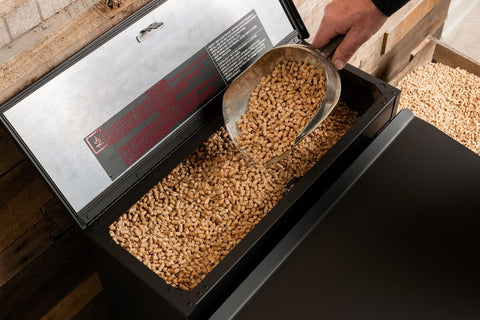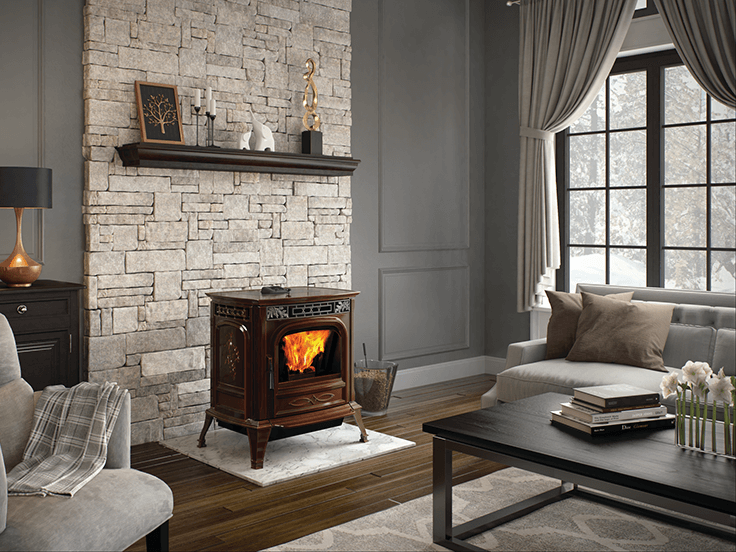Heating a home can be expensive, especially if your home happens to be in a colder climate. As costs of oil and electricity rise, you may be longing for a heat source alternative that can stabilize heating costs. A great potential heating alternative you may want to consider is a pellet stove, which can provide an eco-friendly, cost-effective method for heating your home.
Here we'll explain what a pellet stove is, break down how they work, and touch on some of the pros and cons of owning a pellet stove.
What is a Pellet Stove?
A pellet stove is a heating source similar to a wood-burning stove, but instead of using wood for fuel, pellet stoves burn a renewable biomass fuel called pellets (made of materials like wood chips and sawdust). Pellet heaters are available as freestanding stoves or fireplace inserts, heating part or all of a home (depending on your floor plan).
They are an incredibly eco-friendly option, because they reduce greenhouse gas emissions when used as an alternative to heating oil, propane, or natural gas.
A pellet stove doesn’t match your vision of an antiquated industrial heater. Pellet products are available in a range of looks, so you can opt for a style from traditional to modern to complement any aesthetic.
How do Pellet Stoves Work?
Pellets are poured into a fuel hopper and fed into the combustion chamber by an electric auger. The auger feeds pellets to the burn pot at the correct rate to keep the temperature you set. This means the fire may be roaring, modulate lower, or even go out and relight automatically based on the current temperature of the room versus the temperature you set it to be. Because of the pellet density, pellet stoves produce very little ash and emit extremely low outside air particulates and produce fewer greenhouse gasses than other types of stoves.
Pellet heaters can be used on their own or in conjunction with an existing heating source (like a central furnace or boiler). A pellet stove is a freestanding heater that is placed on a non-combustible surface, and a pellet insert slide into an existing fireplace. The stove can be seamlessly integrated into your living space, either by venting through the chimney or directly out an exterior wall with no pipe showing.
What are the Pros and Cons of Owning a Pellet Stove?
Determining whether a pellet stove is the right heating solution for you should involve evaluating what you're looking for in a heating solution. Considering three factors—your lifestyle, your budget and your heating needs—will help you determine the appliance that is right for you.
Pellet Stove Pros

Using a pellet stove comes with many benefits. Read on as we explore them.
Pellet Stoves are Extremely Efficient Energy Sources
A well-maintained pellet stove is a highly efficient fuel source. Most pellet stoves are able to provide up to 24 hours of steady heat with just one hopper of pellets. Harman pellet stove models are extremely efficient, extracting the maximum amount of heat out of each pellet with minimal ash.
What does this mean for you? You can run your pellet stove on minimal fuel – keeping costs lower than other stove types. What’s more, there’s a federal incentive that permits pellet stove owners to claim a 26% tax credit. The tax credit will increase to 30% with a maximum cap of $2,000 per year as of January 1, 2023.
Pellet Stoves are Environmentally Friendly
Because pellet stoves burn dense pellets made from recycled materials, they expel extremely low particulate emissions. In fact, burning one ton of pellets (rather than using oil) can reduce carbon emissions by nearly 1.5 tons, according to the Pellet Fuels Institute.
Pellets produce fewer greenhouse gasses than fossil fuel systems and are considerably less expensive than renewable energy systems. What's more, when buying a pellet stove, you're doing your part to reduce dependence on foreign oil sources.
Pellet Stoves can Reduce Heating Costs
Many homeowners say the number one reason they install a pellet stove is to reduce heating costs. Depending on the size of the stove and your home, a pellet stove could heat up to 2,500 square feet for as little as $4 per day.
Similar to the concept of a hybrid car, the pellet stove is a primary or secondary heating source, depending on where you live.
The best use case is installing a pellet stove to work in conjunction with an existing central furnace or boiler. You can turn the central furnace temperature down 10 to 15 degrees and use the pellet stove to zone heat the rooms used the most, like your family or living room. Use our pellet fuel savings calculator to see how much a pellet stove could save you on heating costs.
Looking to learn more about how a pellet stove can transform your space? View more pellet stove pros here.
Pellet Stove Cons
While pellet stoves may be highly efficient; they come with a few requirements that may be limiting to some potential owners. You'll need to have the space and electricity to support these appliances, and you'll also need to have a plan to carry out ongoing maintenance to keep them running efficiently.
Pellet Stoves Require Maintenance
In order to continue running efficiently and safely, pellet stoves do require some regular maintenance. You'll need to regularly add pellets, scrape the burn pot, and remove ashes while you're burning. After the cold season, you'll want to perform a deep clean to ensure all parts continue working efficiently in the future.
Luckily, it's fairly simple to maintain a stove to keep it running at its best. As you clean, carefully follow instructions in the owner's manual or hire a professional.
Keep your stove clean throughout the heating season to make sure it runs its best. Harman provides weekly, monthly, and yearly stove maintenance tips.
They Take Up Space in Your Home
While selecting a model, you'll want to think through where the pellet stove will go, and find a pellet stove that fits the space and décor in your home.
They Require Electricity
A pellet stove is powered by electricity, so if you lose power, your pellet stove would not operate. If you're relying solely on a pellet stove for heat, you'll likely want to look into a generator or back up battery in the event of a power outage. If you purchase a Harman, here are our recommendations for battery backups: Winter Storm Outage? No Problem. | Harman (harmanstoves.com)
The good news is, the cons of pellet stoves can often be overcome with some advanced planning. Before purchasing a pellet stove, think strategically about where it will go and how you can power it if you lose electricity. Build in time for regular maintenance by attending to it right when the cold season ends.
How to Choose a Pellet Stove
Like any heating appliance, pellet stoves can vary in the features offered and the amount of heat they provide. Cost will likely determine your selection as well.
Today's state-of-the-art technologies make pellet stoves convenient and easy to use. Harman stoves, in particular, boast the most precise temperature accuracy in the industry, keeping your set temperature within one degree. They produce very little ash and do not need to be shut down to perform basic maintenance, providing true 24/7 heat. When it comes to looks, Harman’s elegant flame-reactive mirrored glass is a standard feature that makes every stove look beautiful all year long.
Two popular models to consider are:
- The Harman P43 pellet stove is known as a true powerhouse that provides dependable, consistent heat at your set temperature.
- The Harman Absolute63 pellet stove is the largest cast iron pellet stove on the market. The Absolute63’s digital touch screen makes it possible to easily adjust the heat. It can even schedule changes to temperature and prompt you to perform maintenance, fill the hopper and much more.

Are Pellet Stoves Right for Me?
Weighing your priorities and values can help determine if a pellet stove is a good fit for you. If you're someone who cares about your impact on the environment and wants to save money on your heating bill, a pellet stove can offset regular heating costs.
Before buying a pellet stove, you'll also want to consider the level of maintenance you're willing to put into your heating solution. Pellet stoves offer energy efficiency and cost savings, but they do require some maintenance to continue running efficiently. You'll also want to consider where a pellet stove will fit in your home. If you already have a fireplace, an insert can work nicely, otherwise you'll need to think through where a pellet stove can fit in your space.
Take the Next Steps
Pellet stoves can be an environmentally friendly, cost-effective, and efficient way to heat your home. When buying a pellet stove, you'll want to weigh the initial investment and routine maintenance required with the ongoing benefits you'll gain.
Browse our products and view the idea gallery to find a pellet stove that fits your needs and taste! Then, visit a Harman pellet stove and insert dealer near you to bring home your new energy-efficient, cost-effective and eco-friendly heating solution.






